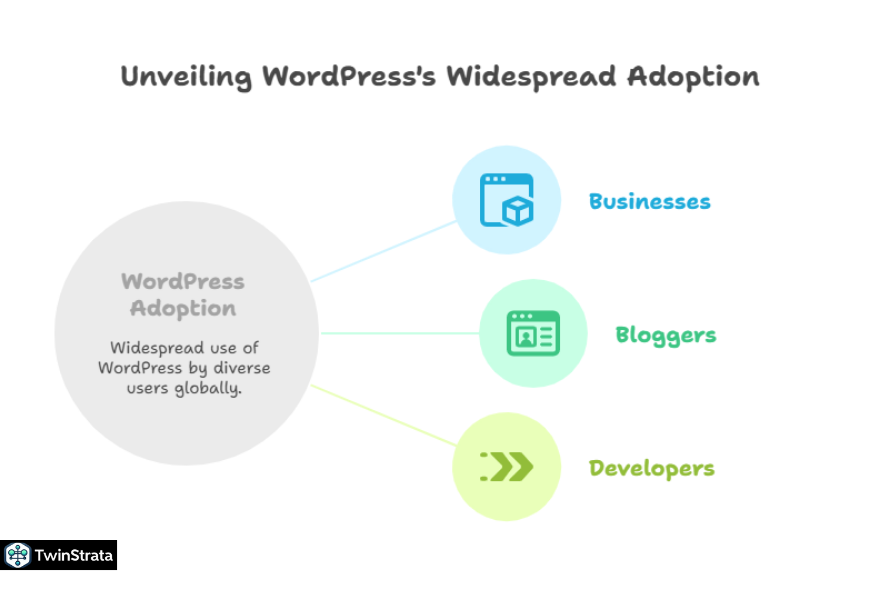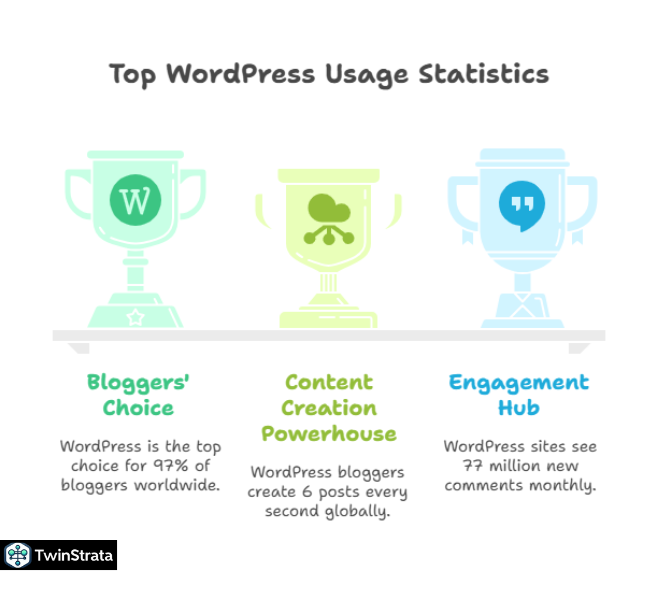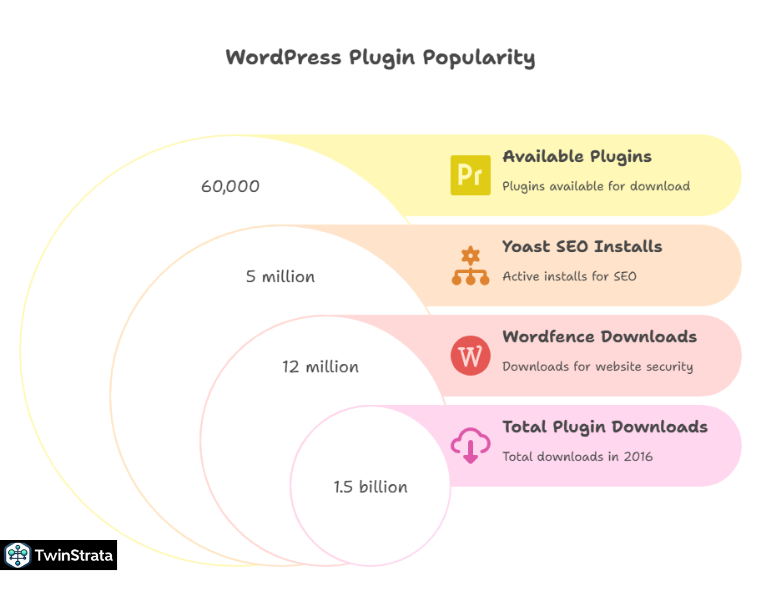WordPress leads the way as the top content management system in 2025. People around the world use it to build everything from simple blogs to complex online stores.
If you want to create a website that grows with your needs, WordPress offers tools that make it easy. You benefit from its free setup, vast community support, and plugins that add features without coding skills.
In this article, we explore the latest WordPress statistics 2025, including the number of websites and users. We draw from recent data and insights from places like Quora and Reddit, where users discuss real-world trends.
These stats show how you can use WordPress to start a blog, launch an e-commerce site, or even earn money as a freelancer.
Table of Contents
ToggleWordPress Statistics 2026 (Top Picks)

Experts report that over 564 million websites worldwide will run on WordPress in 2025. This platform powers 43.4% of all websites on the internet. It holds 60.8% of the global CMS market share. Bloggers favor WordPress, with 97% of them using it.
Developers enjoy over 70,000 plugins for customization. Themes number more than 30,000, giving you endless design options. WordPress sites have grown by 27% in the last decade.
Big names like TechCrunch, CNN, and Spotify rely on it. You can use these stats to see why WordPress fits your goals—whether you build a personal site or a business one.
How Many Websites Use WordPress?
Users power over 564 million websites with WordPress globally. You find this number by looking at total websites, which reach about 1.3 billion according to recent reports.
WordPress takes a huge slice because it simplifies website creation. You install it quickly, add content, and go live without hassle. Businesses choose it for its scalability—you start small and expand as traffic grows.
Bloggers love it for easy posting and SEO tools that boost visibility. Developers appreciate the open-source code, which lets them tweak everything. Sources like Netcraft confirm this dominance, showing how WordPress adapts to any user need.
What Percent of Websites Use WordPress?
WordPress runs 43.4% of all websites worldwide. You see this as the highest share for any CMS. It beats competitors thanks to its user-friendly dashboard and free core software.
If you run a site, you gain from built-in updates that keep things secure and fast. This percentage includes sites from hobbyists to Fortune 500 companies.
You can use WordPress to create a portfolio that attracts clients or a blog that earns ad revenue. Data from W3Techs highlights this lead, proving WordPress’s reliability for long-term projects.
- Also read about: Internet Usage Statistics
WordPress Market Share

WordPress commands 60.8% of the CMS market. You notice this gap when comparing it to others—Shopify holds 6.7%, and Wix has 5.6%. This share comes from WordPress’s flexibility; you customize it for e-commerce, forums, or news sites.
As a user, you benefit by joining a massive ecosystem where help is always available. On Quora, people predict even more growth in 2025 with specialized WordPress versions for niches like education or healthcare.
These distributions make it easier for you to pick a ready-made setup tailored to your industry.
Here is a table showing WordPress’s market share compared to other CMS platforms:
| CMS Platform | Market Share |
| WordPress | 60.8% |
| Shopify | 6.7% |
| Wix | 5.6% |
| Squarespace | 3.1% |
| Joomla | 2.2% |
| Drupal | 1.5% |
General WordPress Statistics

Users prefer WordPress for its functionality and ease. It serves as the top blogging platform and CMS. Bloggers use WordPress in 97% of cases because it handles posts seamlessly.
You publish six posts per second on average across all sites. This adds up to 8,538,048,000 posts yearly. Comments flow in at 77 million new ones each month.
Back in 2018, WordPress powered just 29.2% of sites, but it has grown steadily. You can tap into this by starting a blog that engages readers and builds your brand.
WordPress Usage Statistics
WordPress began as a blogging tool but evolved into a full CMS. Users report using it as a CMS in 69% of cases, while 20% mix blogging and CMS features. Only 6% stick to blogging alone.
Among the top 1,000 sites, 30.3% run on WordPress. It grows fastest among CMS platforms for 11 years running. You use it to manage content without tech headaches—update pages, add images, and track visitors all in one place.
Here is a table of how users employ WordPress.
| Use of WordPress | Percentage of Users |
| CMS | 69% |
| Both CMS and Blog | 20% |
| Blog | 6% |
WordPress Revenue and Marketplace
WordPress claims 43% of all websites’ market share. You see this in its edge over Shopify at 3.2%, Joomla at 2.2%, and others. Among top 100,000 sites, it holds 35.94%.
Growth hits 27% over the decade. For the top 10,000 sites, it’s 38.03%. You benefit as a business owner by using WordPress to cut costs—free themes and plugins keep expenses low while scaling up.
Here is a table of market share percentages for CMS platforms across all websites:
| CMS Platform | Percentage of Market Share |
| WordPress | 43% |
| Shopify | 3.2% |
| Joomla | 2.2% |
| Drupal | 1.5% |
| Squarespace | 1.5% |
| Wix | 1.5% |
WordPress Traffic Statistics
Traffic surges on WordPress sites. Around 409 million people view over 20 billion pages monthly. Users post 70 million new entries each month. Comments add 77 million more.
Unique visitors hit 163 million monthly. You boost your site’s traffic by optimizing with SEO plugins, which help search engines find your content. This turns visitors into customers or subscribers.
In How Many Countries Do People Use WordPress?

People use WordPress in over 178 countries. It supports more than 60 languages, making it accessible worldwide. The United States leads with about 9 million sites.
Russia follows with 550,000, then the United Kingdom at 380,000. You expand globally by translating your site easily—plugins handle multiple languages to reach new audiences.
Here is a table of countries with the most WordPress websites:
| Rank | Country | WordPress Websites |
| 1 | United States | 9 Million |
| 2 | Russia | 550K |
| 3 | United Kingdom | 380K |
| 4 | Iran | 280K |
| 5 | India | 275K |
| 6 | Canada | 222K |
| 7 | Australia | 161K |
| 8 | Brazil | 123K |
| 9 | Vietnam | 114K |
| 10 | Germany | 10K |
Active websites number 3,777,615 in the U.S., 1,765,106 in Germany, and so on.
Here is a table of active WordPress websites by country:
| Country | Number of Active Websites |
| United States | 3,777,615 |
| Germany | 1,765,106 |
| United Kingdom | 1,346,012 |
| Brazil | 1,048,503 |
| France | 975,972 |
| Netherlands | 895,373 |
| Italy | 870,199 |
| Russia | 739,255 |
| India | 724,223 |
| Japan | 710,408 |
Source: WordPress.org, Statista
WordPress Version Statistics
Developers release 43 major versions since WordPress started. Version 6 dominates at 53.8% usage. Version 5 follows at 39.1%. You update to the latest for better speed and security—Version 6.1 leads with 54.3% of sites. Releases happen 2-3 times yearly, like Version 6.1 on November 1, 2022.
Here is a table of user percentages by version:
| Version | Percentage of Users |
| Version 2 | <0.1% |
| Version 3 | 0.4% |
| Version 4 | 6.6% |
| Version 5 | 39.1% |
| Version 6 | 53.8% |
Most used sub-versions include 6.1 at 54.3%, 6.0 at 9.9%.
Here is a table of top versions:
| Version | Percentage of Websites |
| 6.1 | 54.3% |
| 6.0 | 9.9% |
| 5.9 | 4.8% |
| 5.8 | 5% |
| 5.7 | 3.1% |
| 5.6 | 2.1% |
| 5.5 | 2.8% |
| 5.4 | 2.9% |
| 5.3 | 2.2% |
| 5.2 | 2.1% |
Release dates span from 5.1 in February 2019 to 6.1.1 in November 2022.
Here is a table of release dates:
| Version | Release Date |
| 5.1 | February 21, 2019 |
| 5.2 | May 7, 2019 |
| 5.3 | November 12, 2019 |
| 5.4 | March 31, 2020 |
| 5.5 | August 11, 2020 |
| 5.6 | December 8, 2020 |
| 5.7 | March 9, 2021 |
| 5.8 | July 20, 2021 |
| 5.9 | January 25, 2022 |
| 6.0 | May 24, 2022 |
| 6.1 | November 1, 2022 |
| 6.1.1 | November 15, 2022 |
WordPress Plugin Statistics

One of WordPress’s greatest strengths is its extensibility through plugins. You can find a plugin for almost any functionality you can imagine.
- Security Matters: The Wordfence security plugin has seen more than 12 million downloads, highlighting the importance users place on website security.
- Vast Free Plugin Library: The official WordPress.org directory offers around 60,000 free plugins.
- Billions of Downloads: In 2016 alone, there were 1.5 billion plugin downloads from WordPress.org, a number that continues to grow.
- SEO is Key: Yoast SEO stands out as the most popular plugin, with over 5 million active installations and over 463 million downloads. It helps websites rank higher in search engines.
Here is a table of plugin subcategories by website percentage:
| Subcategory | Percentage of Websites |
| WooCommerce | 20.4% |
| Elementor | 16.0% |
| WPBakery | 15.3% |
| Beaver Builder | 1.0% |
| NextGEN Gallery | 0.9% |
| 10 Web Photo Gallery | 0.7% |
| Bb Press | 0.6% |
| Buddy Press | 0.5% |
| Wp Foro | 0.2% |
| Visual Composer | 0.2% |
| Oxygen | 0.2% |
| FooGallery | 0.2% |
| Seed Prod | 0.1% |
| Robo Gallery | 0.1% |
| Page Layer | 0.1% |
| Supsystic Photo Gallery | 0.1% |
| Asgaros Forum | 0.1% |
| Modula Albums | 0.1% |
| Envira Gallery | <0.1% |
| AnsPress | <0.1% |
| Grand Flagallery | <0.1% |
| WP eCommerce | <0.1% |
| WP EasyCart | <0.1% |
| Carrot | <0.1% |
| eCommerce Product Catalog | <0.1% |
| MarketPress | <0.1% |
| Shopp | <0.1% |
| Simple: Press | <0.1% |
| Other | 43.1% |
Jetpack sees over 120 million downloads. Popular categories include SEO, speed, page builders, forms, security, and backups.
Here is a table for SEO plugins:
| Plugin | Active Installations |
| Yoast SEO | >5 million |
| All-in-One SEO Pack | >2 million |
| RankMath | >800,000 |
Speed plugins table:
| Plugin | Active Installations |
| JetPack | >5 million |
| WP-optimize | >1 million |
| NitroPack | >60,000 |
Page builders:
| Plugin | Active Installations |
| Elementor | >5 million |
| SiteOrigin Builder | >1 million |
| Beaver Builder | >300,000 |
Contact forms:
| Plugin | Active Installations |
| Contact Form 7 | >5 million |
| WP Forms | >4 million |
| Ninja Forms | >1 million |
Security:
| Plugin | Installations |
| Wordfence Security | >4 million |
| iThemes Security | >1 million |
| Sucuri Security | >800,000 |
Backups:
| Plugin | Active Installations |
| Updraft Plus | >3 million |
| BackWPup | >700,000 |
| VaultPress | >60,000 |
- Also read about: 16 Most Important WordPress Plugins
WordPress Theme Statistics

Users access over 30,000 themes, with 13,000 free on WordPress.org and 12,000 paid on ThemeForest. Average premium theme costs $77.57. Choices theme appears on 13% of sites.
Divi and Astra top for top 1 million sites. You pick themes to match your style—free ones suit beginners, premiums add pro features like sliders.
Here is a table of most used themes:
| Theme | Percentage of Sites |
| Choices | 13% |
| Divi | 7% |
| Astra | 5% |
| Popper | 5% |
| Avada | 3% |
| Generate Press | 3% |
| Others | 64% |
Astra downloads exceed 7 million. Free themes total over 9,000. On Envato, Avada sells over 1 million copies.
WordPress Security Statistics
Security matters for all sites. Wordfence blocked 18.5 billion password attacks in early 2021. Attacks hit 90,000 per minute. WPScan noted 602 vulnerabilities in 2021, mostly in plugins (90%).
Brute force causes 16.1% of hacks. Outdated software led to 39% of breaches. XSS vulnerabilities make up 52%. From a 2025 Reddit security survey, only 27% of users have recovery plans.
Top concerns include downtime at 59%, data theft at 53%, and defacement at 50%. You protect your site with plugins like Wordfence—update regularly and use strong passwords to avoid issues.
Here is a table of vulnerability types:
| Vulnerability Type | Percentage |
| XSS | 52% |
| File Upload | 7% |
| Access Controls | 12% |
| SQL Injection | 13% |
| CSRF | 16% |
WordPress Community
The community drives WordPress as open-source. Translators cover 56 languages fully. Facebook groups boast thousands of members.
In 2017, 128 WordCamps happened in 48 countries, selling 40,000 tickets. You join meetups to learn tips and network—contribute code or ideas to shape future updates.
How Much Do People Make with WordPress?

Freelancers earn well with WordPress skills. 32% charge $10-19 hourly, 28% $20-28. Entry-level developers start at $40,000 yearly, rising to $150,000 with 5+ years. U.S. freelancers average $70/hour generally, $90 in specialized markets.
Glassdoor lists average developer salary at $67,837. You freelance on platforms like Upwork—build sites for clients and charge based on complexity.
Here is a table of salaries by experience:
| Years of Experience | Average Salary |
| <2 years | $40,000 |
| 3-5 years | $70,000 |
| >5 years | $150,000 |
Hourly rates by country:
| Country | Hourly Rate |
| United States | $70 |
| Worldwide | <$35 |
Specialized rates:
| Country | Hourly Rate |
| United States | $90 |
| Worldwide | $75 |
Salary ranges from sources:
| Source | Minimum | Average | Maximum |
| Talent.com | $55,000 | $70,167 | $105,000 |
| Glassdoor | $39,000 | $67,837 | $118,000 |
| Delicious Brains | $45,000 | $65,000 | $150,000 |
| Zip Recruiter | $24,000 | $64,308 | $106,500 |
| Indeed | N/A | $58,122 | N/A |
| Simply Hired | $28,235 | $57,218 | $115,948 |
WordPress Trends for 2026
Small businesses use WordPress for e-commerce via WooCommerce, which holds 33.85% market share. It integrates payments easily. Drag-and-drop builders like Elementor simplify design.
Navigational structures improve user experience. Mobile-friendly sites rise across niches. Gutenberg and Full Site Editing expand. Estimates predict 50% of sites on WordPress soon.
On Quora, users expect more distributions—free or paid versions for specific uses. Reddit discussions highlight WooCommerce’s role in e-commerce, with retail sales projected to hit $7.5 trillion. You adopt these trends by going mobile-first to capture more visitors.
How Many Websites Use WooCommerce?
WooCommerce powers 115 million sites, or 8.9% of all websites. It leads e-commerce at 33.85%. You set up an online store quickly—add products, process payments, and track orders. This beats Shopify’s 19.94%.
What do people ask? Insights from Quora and Reddit
From Reddit :
- What’s the Future of WordPress? Your Thoughts on 2025 and Beyond?
- Context: “WordPress has been evolving rapidly, with block editing, full-site editing, and now AI integrations. But what’s next? Will WordPress stay the king of CMS platforms? Personally, I think the focus will shift more towards AI-powered tools and making websites even faster and easier to manage. What do you think?”
- Why relevant: Users debate growth stats and predict if WordPress will hit 50% market share by 2026, tying into 2025 adoption numbers.
- WordPress share of sites has been flat to down since 2021, which helps explain Matt’s behavior
- Context: “Around 472 million websites use WordPress as of 2025. This represents around 43.6% of all websites… The platform is still healthy, but if Matt [Mullenweg] is going to satisfy his investors, he needs growth.”
- Why relevant: Sparks talks on stagnant 43% market share stats and what it means for users relying on WordPress for business.
- 2025 WordPress Security Survey, let’s discuss
- Context: “We just wrapped up our annual WordPress Security Survey… The two most common causes of successful WordPress hacks are mainly user problems; outdated software and accounts hijack.”
- Why relevant: Focuses on vulnerability stats (e.g., 90% from plugins) and how 2025 surveys show rising attacks, perfect for site owners checking security metrics.
- What’s your go-to statistics plugin?
- Context: “I use a combination of Sitekit + WP statistics to track my websites analytics, however the latest wp statistics update has made the plugin very unstable… What’s everyone else using?”
- Why relevant: Ties into traffic and visitor stats, with users sharing 2025 plugin performance data for accurate WordPress analytics.
From Quora:
- How do you expect the future demand of WordPress to be in 2025?
- Context: “WordPress is an ecosystem of core, extensions, and themes… In 2025, we will see an increasing number of WordPress distributions, which can be free, paid, generic, or specialized.”
- Why relevant: Explores demand stats, predicting growth in specialized setups amid 60%+ CMS market share.
- Is WordPress in 2025 dying?
- Context: “Nope, WordPress is far from dying! In fact, it’s still the most popular website builder in 2025, powering over 40% of all websites… ✔️ Flexibility – From blogs to eCommerce.”
- Why relevant: Directly questions survival stats, with answers citing 43% global usage and why it’s thriving.
- What should the WordPress development road map look like for 2025?
- Context: “For anyone wanting to become a WordPress developer, what should the WordPress development roadmap look like for 2025? Before learning WordPress, you should know basic terminology…”
- Why relevant: Guides on skills for a market with steady developer demand, linking to job stats around $70K average salaries
FAQs About WordPress Statistics
1. How many websites use WordPress in 2025?
Over 564 million websites use WordPress in 2025, making it the most popular platform for building online presence.
2. What is WordPress's market share in the CMS world?
WordPress holds 60.8% of the CMS market share, which allows users like you to access a wide range of tools and community support.
3. How can I benefit from using WordPress for my business?
You benefit from WordPress by creating a customizable website that scales with your business, integrates e-commerce easily, and optimizes for search engines to attract more customers.
4. What are the top plugins for WordPress in 2025?
Top plugins include Yoast SEO for optimization, Elementor for building pages, and Wordfence for security, helping you enhance your site’s performance and protection.
5. Is WordPress secure enough for my site?
WordPress offers strong security through regular updates and plugins, but you must use best practices like strong passwords and recovery plans to keep your site safe.
Also Read:
- Google Ads Statistics
- Quora Statistics
- Threads Statistics
- Google Search Statistics
- Mobile Internet Traffic Statistics
Conclusion:
In 2025, WordPress continues to be the most popular platform for building websites. It powers over 43.4% of all websites and 60.8% of the CMS market.
People use it around the world because it’s flexible, easy to use, and works for blogs, online stores, business sites, and more. With thousands of themes, plugins, and strong community support, WordPress helps users of all skill levels create websites that can grow and succeed.
Whether you’re a beginner or a developer, WordPress gives you the tools to build and manage a powerful online presence.
